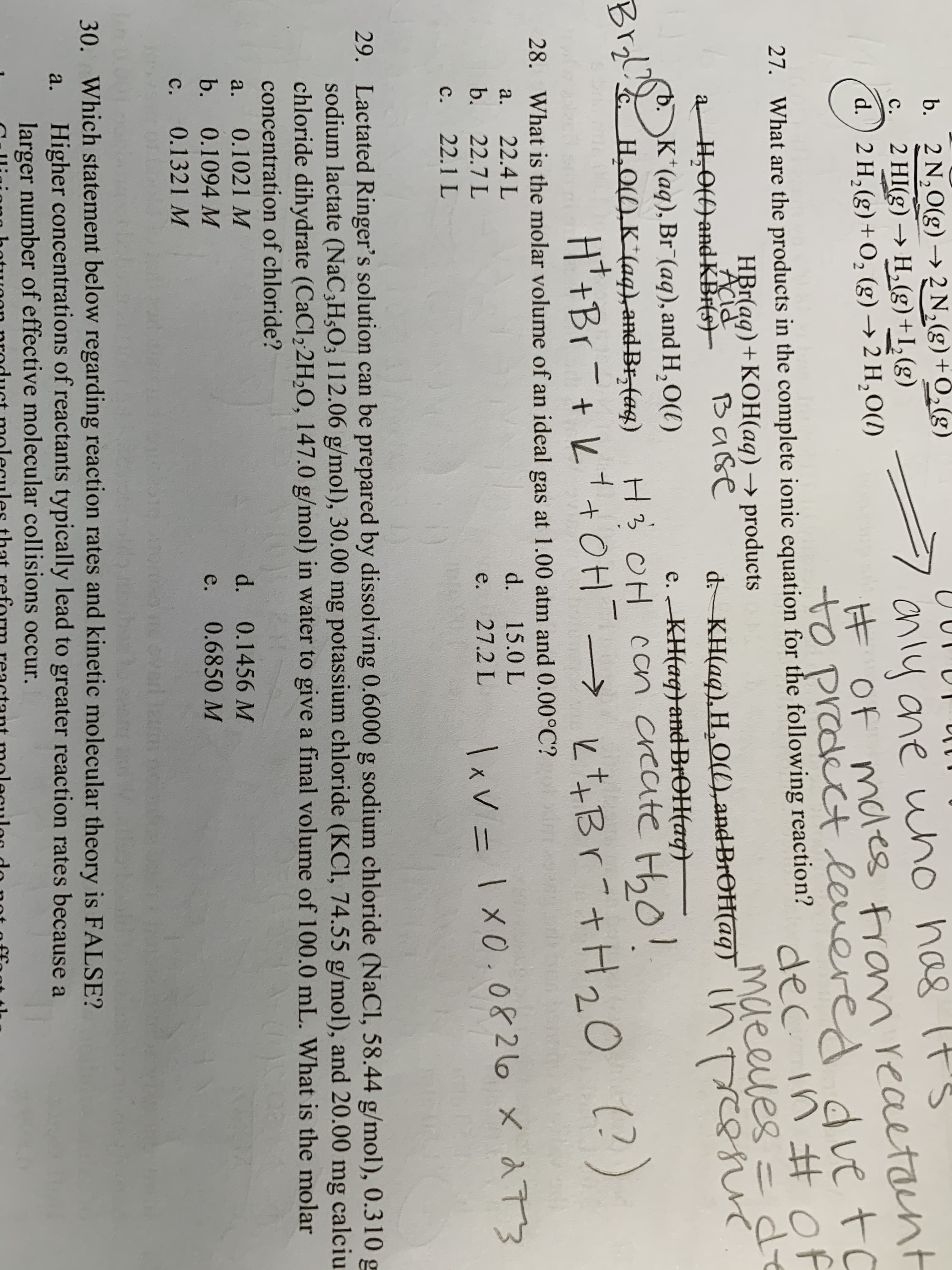b. 2 N,0(g) → 2 N,(g)+0,(g) 2 HI(g) → H,(g)+I,(g) anly ane who has It's ĦOF mdes fran reaetant ed dve to c. d.) 2 H, (g)+O, (g) → 2 H,O(1) to prodect levere dec. 27. What are the products in the complete ionic equation for the following reaction? in Hof de maeeles= ressiuc. HBr(ag)+KOH(aq) → products Base Acid a H,0() and-KBr(s)– b.K*(aq), Br (aq), and H,O(() Brol H.O1), K*(aq),andBr, (aq) d- KH(aq), H,O(),and BrOH(aq) into e. KH(aq}and-BROH(ag) H3 OH con create Hho! H*+Br-+ L+OH → とtなBr +H20 ) Bryl? (?) 28. What is the molar volume of an ideal gas at 1.00 atm and 0.00°C? a. 22.4 L d. 15.0 L b. Ixv = 1 x0.0826 x 2 73 22.7 L e. 27.2 L C. 22.1 L 29. Lactated Ringer's solution can be prepared by dissolving 0.6000 g sodium chloride (NaCl, 58.44 g/mol), 0.310 g sodium lactate (NaC3H5O; 112.06 g/mol), 30.00 mg potassium chloride (KCI, 74.55 g/mol), and 20.00 mg calciu chloride dihydrate (CaCl2 2H2O, 147.0 g/mol) in water to give a final volume of 100.0 mL. What is the molar concentration of chloride? 0.1021 M d. 0.1456 M a. b. 0.1094 M 0.6850 M e. C. 0.1321 M ovarl zum 30. Which statement below regarding reaction rates and kinetic molecular theory is FALSE? Higher concentrations of reactants typically lead to greater reaction rates because a larger number of effective molecular collisions occur. a.
b. 2 N,0(g) → 2 N,(g)+0,(g) 2 HI(g) → H,(g)+I,(g) anly ane who has It's ĦOF mdes fran reaetant ed dve to c. d.) 2 H, (g)+O, (g) → 2 H,O(1) to prodect levere dec. 27. What are the products in the complete ionic equation for the following reaction? in Hof de maeeles= ressiuc. HBr(ag)+KOH(aq) → products Base Acid a H,0() and-KBr(s)– b.K*(aq), Br (aq), and H,O(() Brol H.O1), K*(aq),andBr, (aq) d- KH(aq), H,O(),and BrOH(aq) into e. KH(aq}and-BROH(ag) H3 OH con create Hho! H*+Br-+ L+OH → とtなBr +H20 ) Bryl? (?) 28. What is the molar volume of an ideal gas at 1.00 atm and 0.00°C? a. 22.4 L d. 15.0 L b. Ixv = 1 x0.0826 x 2 73 22.7 L e. 27.2 L C. 22.1 L 29. Lactated Ringer's solution can be prepared by dissolving 0.6000 g sodium chloride (NaCl, 58.44 g/mol), 0.310 g sodium lactate (NaC3H5O; 112.06 g/mol), 30.00 mg potassium chloride (KCI, 74.55 g/mol), and 20.00 mg calciu chloride dihydrate (CaCl2 2H2O, 147.0 g/mol) in water to give a final volume of 100.0 mL. What is the molar concentration of chloride? 0.1021 M d. 0.1456 M a. b. 0.1094 M 0.6850 M e. C. 0.1321 M ovarl zum 30. Which statement below regarding reaction rates and kinetic molecular theory is FALSE? Higher concentrations of reactants typically lead to greater reaction rates because a larger number of effective molecular collisions occur. a.
Introductory Chemistry: A Foundation
9th Edition
ISBN:9781337399425
Author:Steven S. Zumdahl, Donald J. DeCoste
Publisher:Steven S. Zumdahl, Donald J. DeCoste
Chapter13: Gases
Section: Chapter Questions
Problem 136AP
Related questions
Question
question 28 please

Transcribed Image Text:b. 2 N,0(g) → 2 N,(g)+0,(g)
2 HI(g) → H,(g)+I,(g)
anly ane who has It's
ĦOF mdes fran reaetant
ed dve to
c.
d.) 2 H, (g)+O, (g) → 2 H,O(1)
to prodect levere
dec.
27. What are the products in the complete ionic equation for the following reaction? in Hof
de
maeeles=
ressiuc.
HBr(ag)+KOH(aq) → products
Base
Acid
a H,0() and-KBr(s)–
b.K*(aq), Br (aq), and H,O(()
Brol H.O1), K*(aq),andBr, (aq)
d- KH(aq), H,O(),and BrOH(aq) into
e. KH(aq}and-BROH(ag)
H3 OH con create Hho!
H*+Br-+ L+OH → とtなBr +H20 )
Bryl?
(?)
28. What is the molar volume of an ideal gas at 1.00 atm and 0.00°C?
a.
22.4 L
d. 15.0 L
b.
Ixv = 1 x0.0826 x 2 73
22.7 L
e.
27.2 L
C.
22.1 L
29. Lactated Ringer's solution can be prepared by dissolving 0.6000 g sodium chloride (NaCl, 58.44 g/mol), 0.310 g
sodium lactate (NaC3H5O; 112.06 g/mol), 30.00 mg potassium chloride (KCI, 74.55 g/mol), and 20.00 mg calciu
chloride dihydrate (CaCl2 2H2O, 147.0 g/mol) in water to give a final volume of 100.0 mL. What is the molar
concentration of chloride?
0.1021 M
d. 0.1456 M
a.
b.
0.1094 M
0.6850 M
e.
C.
0.1321 M
ovarl zum
30. Which statement below regarding reaction rates and kinetic molecular theory is FALSE?
Higher concentrations of reactants typically lead to greater reaction rates because a
larger number of effective molecular collisions occur.
a.
Expert Solution
This question has been solved!
Explore an expertly crafted, step-by-step solution for a thorough understanding of key concepts.
This is a popular solution!
Trending now
This is a popular solution!
Step by step
Solved in 2 steps

Knowledge Booster
Learn more about
Need a deep-dive on the concept behind this application? Look no further. Learn more about this topic, chemistry and related others by exploring similar questions and additional content below.Recommended textbooks for you

Introductory Chemistry: A Foundation
Chemistry
ISBN:
9781337399425
Author:
Steven S. Zumdahl, Donald J. DeCoste
Publisher:
Cengage Learning


Chemistry
Chemistry
ISBN:
9781305957404
Author:
Steven S. Zumdahl, Susan A. Zumdahl, Donald J. DeCoste
Publisher:
Cengage Learning

Introductory Chemistry: A Foundation
Chemistry
ISBN:
9781337399425
Author:
Steven S. Zumdahl, Donald J. DeCoste
Publisher:
Cengage Learning


Chemistry
Chemistry
ISBN:
9781305957404
Author:
Steven S. Zumdahl, Susan A. Zumdahl, Donald J. DeCoste
Publisher:
Cengage Learning

Chemistry: An Atoms First Approach
Chemistry
ISBN:
9781305079243
Author:
Steven S. Zumdahl, Susan A. Zumdahl
Publisher:
Cengage Learning

Chemistry: Principles and Reactions
Chemistry
ISBN:
9781305079373
Author:
William L. Masterton, Cecile N. Hurley
Publisher:
Cengage Learning

General Chemistry - Standalone book (MindTap Cour…
Chemistry
ISBN:
9781305580343
Author:
Steven D. Gammon, Ebbing, Darrell Ebbing, Steven D., Darrell; Gammon, Darrell Ebbing; Steven D. Gammon, Darrell D.; Gammon, Ebbing; Steven D. Gammon; Darrell
Publisher:
Cengage Learning